This post contains affiliate links. We earn commissions if you purchase products from retailers after clicking on a link from our site. As an Amazon Associate, we earn from qualifying purchases.
What’s a membranophone? A membrane is a thin flat material. A membranophone is an instrument that produces sound by the vibrations of a flat stretched material.
Furthermore there are other classifications of membranophones, including struck, plucked, and friction. I’ll try and point out those as I go.
It sounds kind of technical and obtuse, but it’s not! I’m going to share with you lots of examples of membranophones–so next time you’re asked in your music class you’ll sound super smart by rattling off some of these.
Drums
By far, the most common type of membranophone has another more common name. A drum! They aren’t exactly the same thing as you’ll see later on, but this makes up the most important recognizable category of membranophone.
Drums typically make sound by a stretched membrane being struck by another device, including drumsticks, mallets, or sometimes a hand. After being struck the energy from the striking device transfers a lot of energy to the membrane. In the case of a drum the membrane is often called the drum head, or drum skin.
When the flat drum membrane vibrates and that vibration moves the air the air subsequently rattles the eardrum to where we then perceive sound.
Snare Drum
The snare drum is one of the most recognizable drums because it is so critical to the music we listen to.
The snare drum is a type of membranophone with a special difference that sets it apart.
The snare drum has thin wires stretched across the bottom of the drumhead. When the drumhead is struck, the wires rattle against the drumhead creating a hissing sound.
That hissing sound is crucial for all pop, all R&B, all rock and roll. Any song that has some form of a drumkit (electronic or real) relies on the snare drum.
Because the snare drum is so easy to hear, it’s used to accent the beat. Which, for rock and pop is almost always beats 2 and 4. Besides these accents, the snare drum is used extensively during fills and other embellishments the drummer uses to add interest to the song (such as ghost notes).
The drum itself is struck with a drumstick, so it can be classified as a struck membranophone. However, since the characteristic sound of the drum is the sound of the snare wires rattling against the drumhead, they could also be considered friction membranophones.
Furthermore, you can play the snare drum with brushes that glide across the snare drum face (these brushes are typically used in ballads… and inserting my own opinion here, they sound amazing. I love the sound of brushes. Anyway, this is another example of how the snare can also be considered a friction membranophone.
Snare drums often come in a dual-head configuration, where it has two drumheads, one on top of the drum where you strike it and one on the bottom.
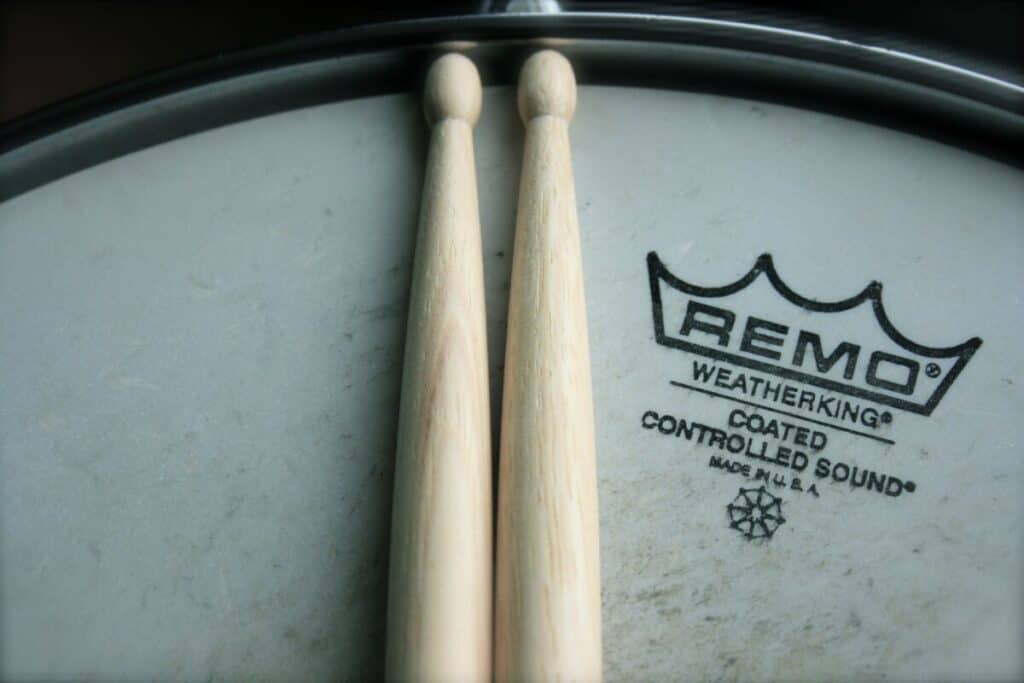
By the way, looking for recording equipment and musical instruments? Check out Sweetwater.com for microphones, monitors, audio interface or any other recording gear that you could ever need. (Affiliate Link)
The top drumhead is designed to be played with two drumsticks.
Tenor Drum / Toms
A tenor drum is a type of large membranophone that varies in diameter from 6 to 14 inches. The tenor drum is often a single-headed drum simply meaning that it has a only single drumhead on the top of the drum.
The tenor drum is designed to be played with two drumsticks.
Tenor drums are somewhat a generic term–in a marching band tenor drums come in multiple configurations. You can play a single tenor drum or you can play what are called “quads”, where 4 tenor drums are attached to a harness that the player carries. It doesn’t stop there, you can over 6 drums in a single configuration.
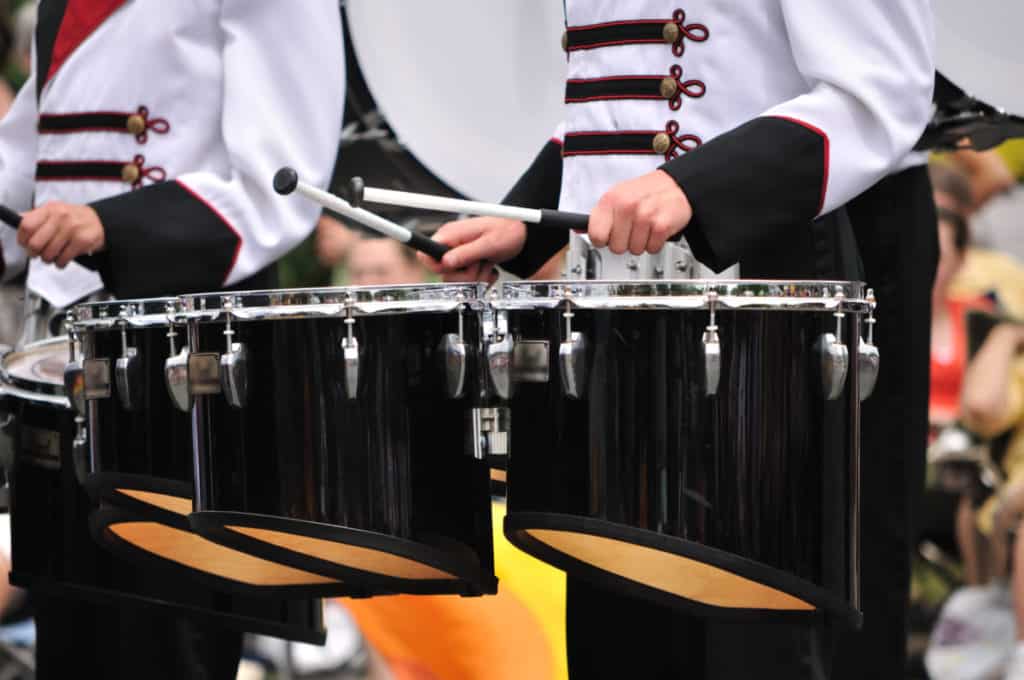
The tenor drum is used extensively in marching bands. The wooden part of the drums are thick which is designed to project the sound and be loud–which is ideal for playing in large open spaces (such as a football stadium).
Toms
A close cousin to the tenor drum is the tom-tom. Tom toms are the same basic concept as the tenor drums but often come in a dual-head configuration (meaning it has a drumhead on the top and on the bottom).
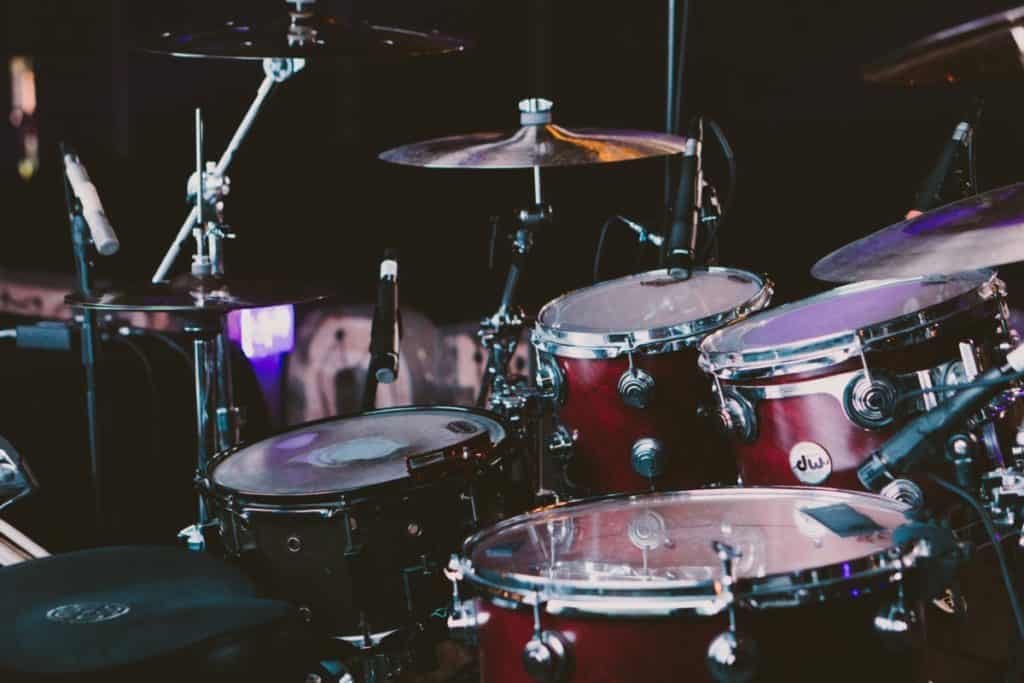
Tom Toms are also designed to be used on a drum kit, so they are able to be mounted in such a way so that the drummer can play all the different drums and cymbals from a seated position.
A special type of tom tom is called the floor tom. The floor tom has the widest diameter out of the drumkit and stands on its own instead of being mounted to the bass drum like the other tom toms. (You can see it in the bottom right hand corner of the above picture).
Tom toms don’t typically cut through the sound of the rest of the band and so they are only really used in fills where the music is transitioning to the rest of the song.
Bass Drum
The bass drum is special type of membranophone that is struck with a mallet.
A mallet is a different type of drumstick where the end of the drumstick ends in a heavier object rather than a small wooden bead.
In the case of a drumkit, the bass drum is played with a kick pedal so the drummer can play multiple drums with their hands and use the kick pedal to play the bass drum. The kick pedal has what is called a kick drum beater which strikes the drum.
Another key difference between bass drums and other drums is that it’s huge. In the case of concert bass drum heads they come in diameters ranging from 26 inches to 40 inches. Drum kit bass drums are much more modest in diameter and range from 16 inches to 22 inches. Although, just like anything, there are exceptions that fall outside of those ranges for drummers who want to experiment.
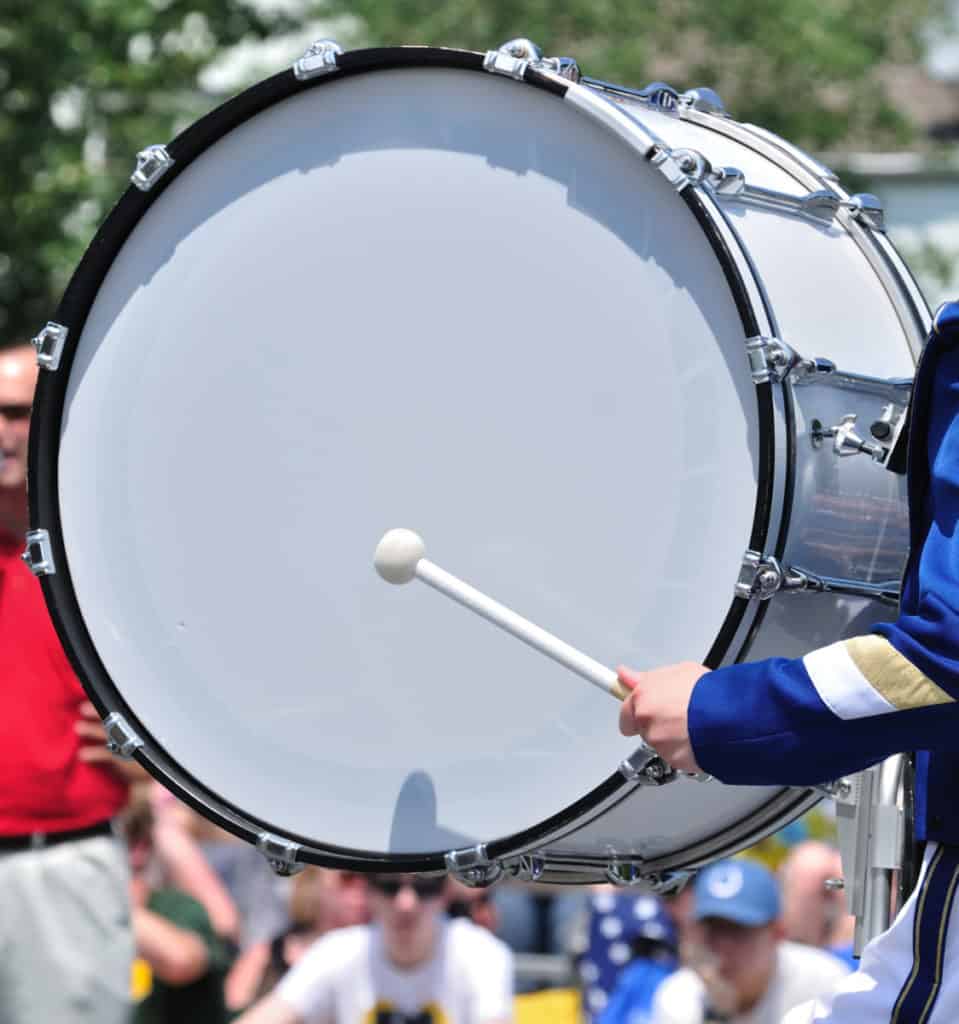
With a larger surface area the bass drum is designed to play lower frequencies. The type of mallet or beater determines the attack of the frequency. The sharper the attack, the more the bass drum is noticed.
The bass drum frequencies are so low that they are used non-melodically. Their sole purpose is to provide emphasis to the rest of the instruments and can be played in such a way to establish a steady beat that drives the song.
Bongos
Bongo drums are another type of membranophone except are unique in that they are actually two drums joined together. Bongos are single-headed, which means they only have drumheads on top of the drums.
Furthermore, unlike all the other membranophones we’ve talked about so far, the bongos are meant to be played with your hands.
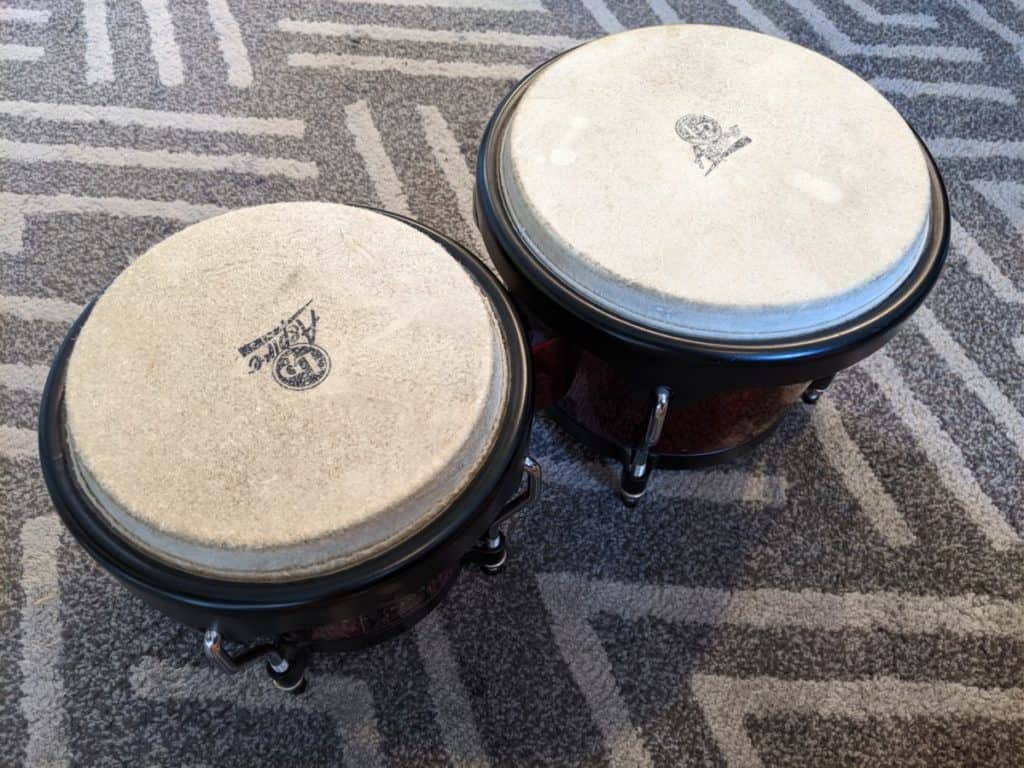
Hand drums are capable of making a wider range of sound because you can play the drum directly on the bearing edge making extremely resonant sounds as well as use your other hand to apply pressure to shape the pitch and timbre of your playing.
I made a video on different bongo drum techniques if you want to see how different this membranophone is from others:
As you can see in the video, you can make more types of sounds from the bongo drums than you might have previously imagined. Even rubbing the drum with your hands gives a kind of brush feel (see the snare section for what I mean)
Congas
Conga drums are another membranophone that people often mix with big bongo drums because they often come in pairs (or sets of 3 or more).
P.S. If you’d like to learn more about congas, bongos, and djembes and what their differences are, make sure and check out my post here that describes all of that in detail.
Congas are hand drums, and like bongos have their bearing edge exposed. This allows for a wide range of diverse sounds. The hands can apply pressure to the drum head and tighten the pitch for particular strikes to create a fantastic array of sounds.
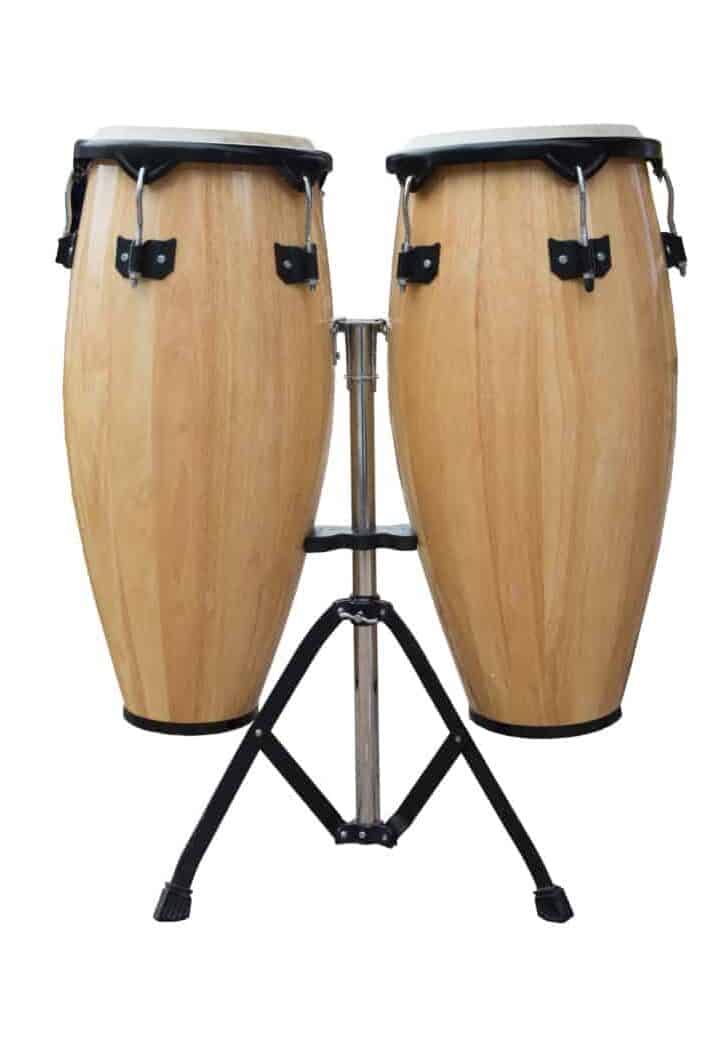
Congas are much larger than other hand drums and are around 2 and a half feet long and are around 9 to 13 inches in diameter (at the drumhead). Conga drumshells are typically curved and are wider in the midsection. They can be played while resting on the floor but they are often placed on a stand as you see in the above picture.
Djembe
The djembe drum is another membranophone that is played with the hands and is similar in size to the conga. Djembe drums can be over 2 feet long or they can very small (10 inches tall). Their drumhead diameter is typically larger than a conga drum.
The djembe is in the shape of a goblet with the drumhead being the widest section and tapering down to a thinner midsection.
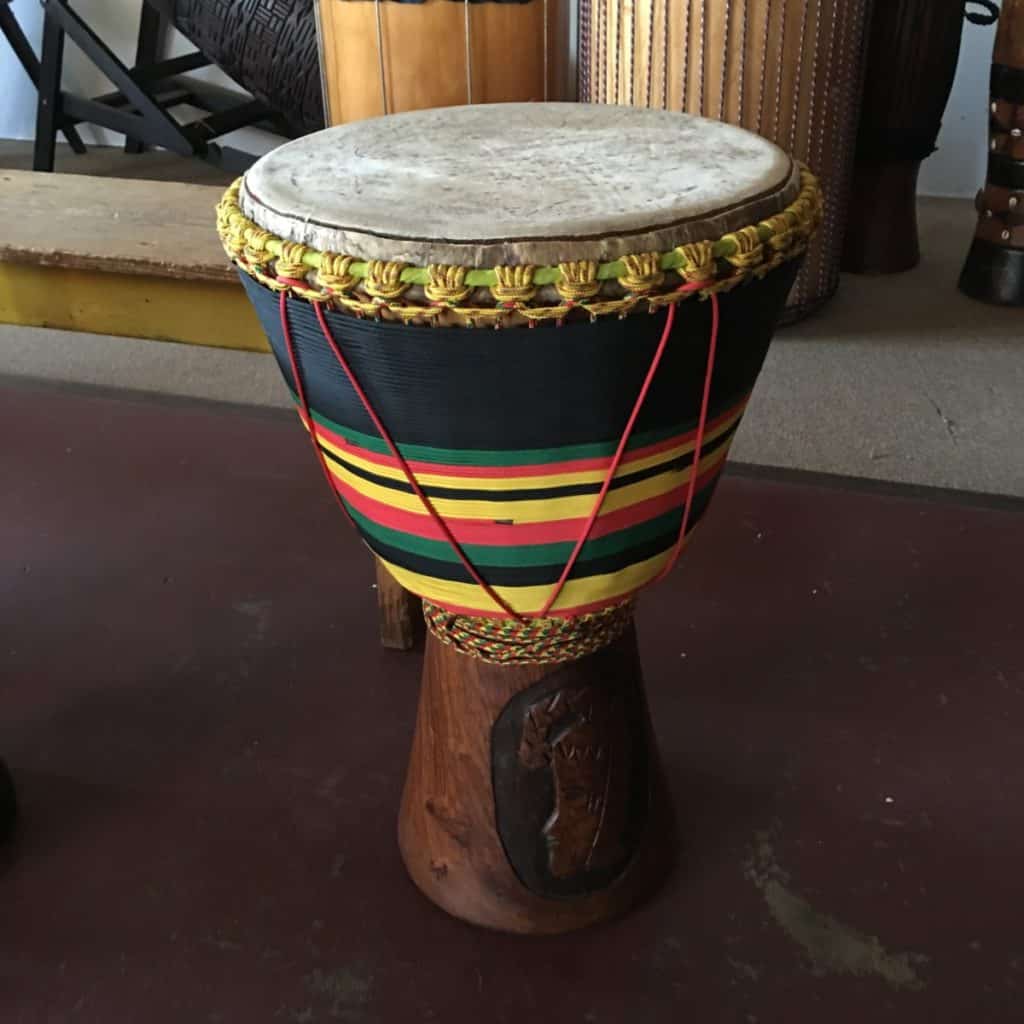
The djembe has a different sound than the bongos or the congas because its drumhead is comparatively thinner and looser.
Timpani
Timpani are a somewhat strangely shaped membranophone. Instead of cylinder-shaped, they look like half a dome.
Timpani are often used in orchestral music and they have a fantastic deep but pitched sound (unlike a kick drum for example). Some timpani even have a pedal so you can adjust the tuning while you play, something that is not common to see with other types of drums.
Timpani are played with mallets and thus don’t have a sharp attack, and they are often played in groups so multiple notes can be played in a piece of music. Think about the intro to 2001: Space Odyssey. The famous bom-bom bom-bom repeating are from the timpani!
Now you’re probably thinking–ahhhh, I know the timpani!
Tabla
Tabla are a very melodic type of membranophones that can be pitched and played to mimic human speech.
They are similar in form to bongos in that they are a pair of drums that are played together. Also similar to bongos, different hand techniques causes different sounds of the drum. However their sound is different and distinct. Bongos are tuned much higher and their sound is more flat than the tabla.
Tambourine
Certain types of tambourines are membranophones, while others are simply idiophone (something in which the body makes the sound, like a cymbal or a bell). Tambourines have jingly cymbals on them that when shaken ring with that classic tambourine sound.
The tambourine style that is a membranophone is the kind with a drum head attached. This drum head can be played with the fingers to add to the rhythm of the small cymbals.
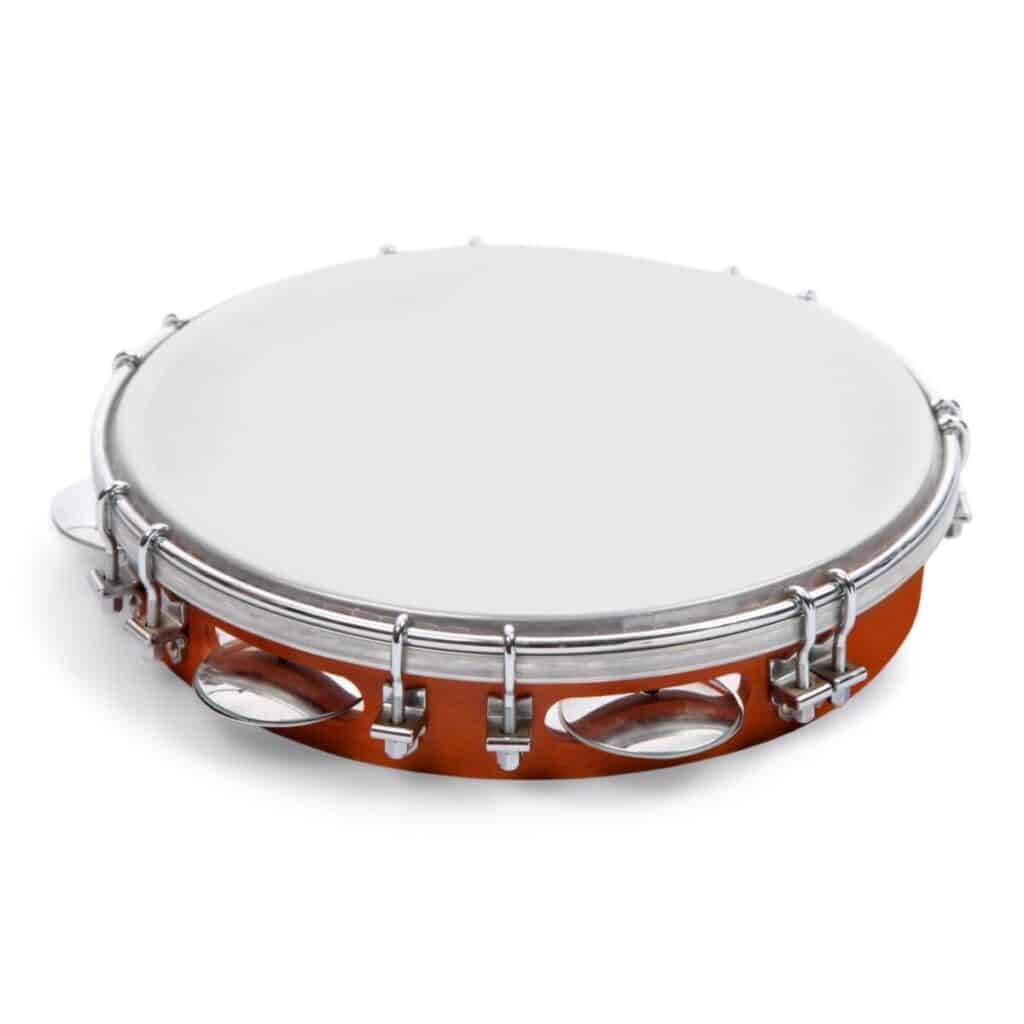
Melodic
Believe it or not, there are a few membranophones that aren’t drums that actually can make melodies!
Kazoo
The kazoo is a small membranophone that you hum into. The air and humming vibrates across a diaphragm which causes a buzzy sound that can be adjusted in pitch by the pitch of the humming. The higher the humming, the higher the pitch–while the lower humming, the lower the pitch of the kazoo.
The kazoo is considered a toy instrument by most.
The kazoo sounds very similar to another type of homemade membranophone called the comb and paper.
Comb and Paper
You may have heard this in some obscure song now and again (such as in the Beatle’s song Lonely Rita).
You can make your own comb and paper simply by singing/humming through an adjacent comb and paper.
This video helps make it abundantly clear how this works.
Other
These don’t really fit anywhere and probably many would argue they don’t belong in the category of membranophone, but most likely because people are not sure exactly where these belong at all! You’ll see what I mean if you keep reading.
Body Percussion
You probably haven’t thought of this before, but our bodies are covered by a large organ that is a relatively thin membrane called our skin. In fact, many hand drums are made from the skin of animals such as goats or cows.
You can play sophisticated beats by slapping your own skin (not too hard or you’ll leave a mark ? ).
Think I’m making this up? Check this out:
I will admit that body percussion could definitely be considered idiophonic since it’s more than just the skin that’s making the sound. The body in general is
Ear Drum
This isn’t exactly a membranophone because the ear drum isn’t exactly a musical instrument, but as I was thinking about the definition it made sense that the ear drum fits in this category.
Our ear drum, also called the tympanic membrane (name sound familiar? Read more on Wikipedia as you wish), is a tiny membrane that vibrates when excited air molecules reach it. The tiny membrane transfers this energy to the ossicles which in turn vibrates the cochlea which is a network of tunnels and nerves that translate all that vibration into something our brain understands.
A membranophone is a category of instrument wherein a vibrating membrane creates the sound. The ear drum isn’t exactly producing the sound, but is receiving it but it is crucial in the process of taking the energy from vibrating air and making it the beautiful amazing sounds we hear.
Anyway, it’s an interesting biological analogy that gets you thinking about the membranophone concept.
Diaphragm Elk Call
Okay, you’re probably thinking I’ve strayed well off the beaten path. But the Greek suffix “phon” means sound (wordreference.com). You wanted examples of membranophones–well, here they come!
The diaphragm elk call is used to mimic an elk (as you might expect) and it is simply a diaphragm (membrane) that vibrates when you breathe through it in a precise way.
In case you were wanting to fellowship some elk (I mean I don’t know… I was just curious), you can find these on Amazon for pretty cheap.
